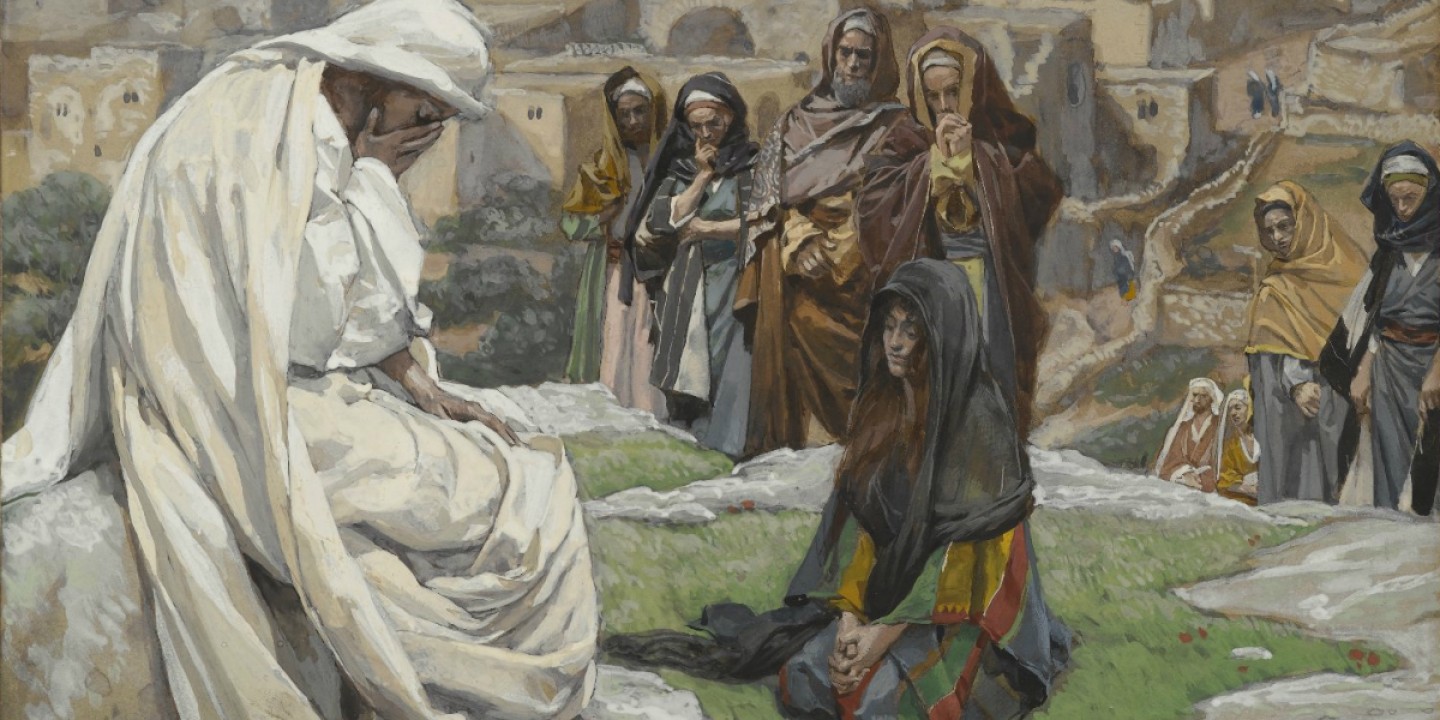
I suspect that most Christians, were they facing brain fog on a quiz show, could manage to summon “Jesus wept” (John 11:35, KJV) as evidence of his humanity. It’s comforting to realize the man cried. He’s one of us.
I recall citing the verse in a seminary paper describing the improbably balanced dual natures of Jesus: fully divine and fully human. Facing personal disappointment, grief, or setback, it’s nice to know that the Son of God has emotions, just like us.
When my three children were young, sometimes they were embarrassed by their own tears in a school setting—following athletic loss, settling for understudy instead of a starring role in a theater production, or lamenting the death of a beloved fourth-grade mascot (a hamster named Furball). Surely they tired of hearing from their pastor/father how even Jesus cried when he was sad.
Read our latest issue or browse back issues.
When Jesus arrives in Bethany after the death of Lazarus, he famously weeps. Some neighbors say, “See how he loved him!” (11:36). I’ve no doubt that Jesus loved his friend. He seems to have spent time dining in the home of these three siblings, maybe just hanging out for a while in a setting where he could let his hair down. He knows Mary, Martha, and their brother better than many other characters described in the Gospels.
And if the man was indeed fully human, then some deaths must have affected him more than others. I was a pastor for over three decades and presided over hundreds of funerals. None of them was easy. But the death of my friend, Bill, after a yearlong struggle with brain cancer, left me weeping at traffic lights and breaking into tears at unpredictable moments. We’d backpacked together on numerous Appalachian Trail hikes. At his funeral, I could not even muster the words “body of Christ” for communicants as they made their way forward. I just handed people the bread, crying, wordlessly.
Some deaths affect us more than others. See how he loved him. Bethany literally means “house of affliction.” Jesus was constantly walking into various states of affliction. That he was emotionally moved by some more than others only underscores his full humanity. This will preach.
But it’s the candid reaction of a second neighborly faction that’s caused me to reassess the nature of Jesus’ tears in this old story. They ask, “Could not he who opened the eyes of the blind man have kept this man from dying?” (11:37). It’s a fair question that echoes over millennia, not to mention on the lips of my own agnostic friends. If Jesus has it in him to still wind and wave, why does he allow earthquakes and tsunamis? If he fed 5,000 with a little boy’s little lunch, why does anyone anywhere go to bed hungry at night? If he healed that blind guy in the town down the road, why doesn’t he show up here in Bethany and work his magic?
The neighborly chorus reflects questions of theodicy as old as Job. They voice objections already aired by the grieving sisters, repeated word-for-word by each: “Lord, if you had been here, my brother would not have died” (11:21, 32).
No explanation is ever offered for Jesus’ tardiness after he learns of his friend’s illness. He lingers “two days longer in the place where he was” after hearing the news (11:6) and finally shows up four days after the funeral (11:17). (Most pastors would, of course, be in trouble if they remained on vacation after receiving word of a parishioner’s dire illness and then returned home to discover a dead body—no matter how well the fish were biting.)
Jesus says something odd to his disciples: “This illness does not lead to death” (11:4). Either this statement is a classic misdiagnosis—like the tears, a missed social cue perhaps strengthens Jesus’ humanity—or something else is going on below the surface. In John’s Gospel, something else is always going on below the surface
If you’d been here, ask the sisters, and what person of faith hasn’t at least thought this while living with tragedy? We Lutherans like to talk about Jesus’ real presence in the Eucharist; we are less forthcoming in naming his seeming real absence in the agonies of life. But note that Jesus does more than simply receive the sisterly ire and neighborly skepticism with patience lacking apology. He curtly questions Martha on the road, countering with a minilecture about the resurrection and questioning whether she really believes it (11:25–26, and again at the tomb in 11:40).
Jesus’ words offered to God at Lazarus’s tomb remind me of pastors who, after the sermon concludes, use a pastoral prayer to continue to take aim at the congregation: “I know that you always hear me, but I have said this for the sake of the crowd standing here.” He seems to be saying, thanks for listening to me, Lord, but I’m praying mostly on behalf of these thickheaded dullards standing behind me just now.
These details—the tardiness, the terse response to a sister, and the cheeky prayer aimed at impertinent neighbors—all lead me to question whether Jesus’ famous tears are often misinterpreted. Notice how Jesus is “greatly disturbed” on either side of his weeping (11:33, 38). The verb in both instances, embrimaomai, means “to snort with anger.” You might imagine a horse pawing the earth and snorting before busting loose in animated irritation.
I’ve been angry at death before, tearfully angry at the injustice of it all. But the details in this old story suggest that Jesus’ tears are more than just tears of human grief for an old family friend who died prematurely. Jesus seems to be weeping on the way to Lazarus’s tomb not only from sorrow but also because he himself is largely misunderstood, and he is not all that happy about it.
We all live in towns called “house of affliction,” filled with innocents who die unfairly. And you probably have friends like one of my close pals who once said, “If your God has the power to change things and can’t or won’t, then I choose not to respect him.” The neighborly chorus from this old story still calls out on every street corner of every town and asks why he who once upon a time opened a man’s eyes could not be bothered to avert this particular tragedy. This question is a small step away from another: If not, then what’s he good for, anyway?
The hopelessly tardy Jesus walks straight into the tomb of Lazarus. Both his absence (perceived by the sisters) and his confounding uselessness (by the neighbors) are given fresh perspective with six powerful words: “Unbind him, and let him go” (11:44).
Tears that won’t seem to stop often accompany crippling sorrow for those we especially love. Inevitable questions about Jesus and his purpose stir into the messy mix of conflicting emotions.
This old story offers another perspective. Jesus weeps, but he refuses to be jerked around by death’s timetable. He talks back to death and boldly walks right toward it—and not only into the tomb of Lazarus. Bethany is just two miles from Jerusalem (11:18).
By cyclically observing the church year and following where Jesus leads the way, his disciples are slowly liberated from death’s great and paralyzing fear. As we face the tombs of others, not to mention our own, this is exactly what Jesus is good for—eclipsing even the expectation of a possible miracle.
Unbind us, Lord. Let us go.
A version of this article appears in the print edition under the title “Jesus wept—but why?”






